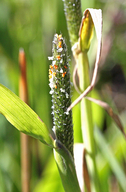Taxon Report
Alopecurus aequalis Sobol. var. sonomensis RubtzoffSonoma alopecurus |
 © 2013 Vernon Smith |
Taxon Summary
Alopecurus aequalis var. sonomensis, commonly known as Sonoma alopecurus, is a perennial herb in the Poaceae that is found only in California. It occurs within Marshes and swamps (freshwater), and Riparian scrub, growing at elevations from 5 to 365 meters. Alopecurus aequalis var. sonomensis is ranked 1B.1, Plants Rare, Threatened or Endangered in California and Elsewhere; Seriously threatened in California.Classification
|
Scientific Name: |
Alopecurus aequalis Sobol. var. sonomensis Rubtzoff |
|
Common Name: |
Sonoma alopecurus |
| Family: | Poaceae |
| Element Code: | PMPOA07012 |
| USDA Plants Symbol: | ALAES |
|
Synonyms/Other Names: |
|
Ecology and Life History
| Lifeform: | perennial herb |
| Blooming Period: May-Jul | May-Jul |
| Elevation: | 5-365 (15-1200) |
| General Habitats: | Marshes and swamps, Riparian scrub |
| Microhabitat: | |
| Microhabitat Details: |
Conservation Status
| CA Rare Plant Rank: | 1B.1 |
| Global Rank: | G5T1 |
|
State Rank: |
S1 |
| State List: | None |
| Fed List: | FE |
| Other Status: | SB_CalBG/RSABG |
|
CRPR Changes: |
|
Occurrence Data from the CNDDB
| Total Occurrences: | 21 |
| Element Occurrence Ranks: | |
| Excellent (A) | 0 |
| Good (B) | 3 |
| Fair (C) | 2 |
| Poor (D) | 3 |
| None (X) | 6 |
| Unknown (U) | 7 |
| California Endemic: True | |
| California Counties and Islands: Name (Code) | |
| Marin (MRN), Sonoma (SON) | |
| Quads: Name (Quad Code) | |
| Bolinas (3712286), Camp Meeker (3812248), Drakes Bay (3812218), Duncans Mills (3812341), Inverness (3812217), Kenwood (3812245), Sebastopol (3812247), Two Rock (3812237) | |
Threat List Data from the CNDDB
| Threat List Total: | 6 | |
| EOs with Threat Listed: | Total EOs | % of EOs |
| 13 | 62 % | |
| Grazing | 10 | 47% |
| Other | 5 | 23% |
| Foot traffic/trampling | 3 | 14% |
| Non-native plant impacts | 3 | 14% |
| Development | 2 | 9% |
| Altered flood/tidal/hydrologic regime | 1 | 4% |
Citation
California Native Plant Society, Rare Plant Program. 2025. Rare Plant Inventory (online edition, v9.5.1). Website https://www.rareplants.cnps.org [accessed 16 December 2025].